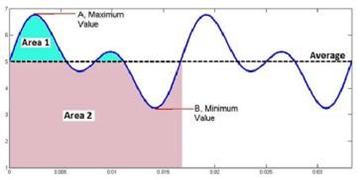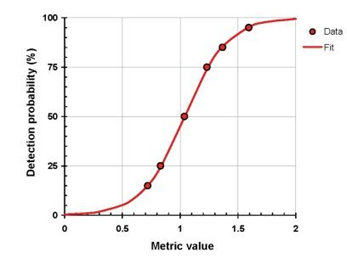Frequency here is the frequency of light output of a tested lighting product.
Flicker Index:IESNA 2000)
FI =
Area1
![]()
Area1 + Area2
Flicker Index is defined as the area between the curve representing the waveform and the average light level divided by the total area below the curve for a single cycle of the fluctuation.
Percent Flicker,Modulation Depth
Percent Flicker or modulation depth is defined as the difference between maximum and minimum light level divided by the sum of maximum and minimum light level(multiplied by 100%).

IEEE Std 1789-2015:IEEE Recommended Practices for Modulating Current in High-Brightness LEDs for Mitigating Health Risks to Viewers)
NM is the abbreviation of normalized modulation,and is used to evaluate the risk level of flicker.
NM1 = 1 represents the limit value of High-Risk Level.
NM 2 = 1 represents the limit value of Low-Risk Level .
IEC TR 61547-1:2015 Equipment for general lighting purposes-EMC immunity requirements:part 1-An objective voltage fluctuation immunity test method ):
Pst here is the measured parameter to quantify the flicker of lighting products,which is proposed by IEC TR 61547-1 depending on IEC61000-3-3,IEC61000-4-15,etc.
Pst=1 represents the average observer just feel the flicker with the probability of 50%.
Joint Appendix JA10-Test Method for Measuring Flicker of Lighting Systems and Reporting Requirements)
This test method measures the fluctuation of light from lighting systems and processes this signal to quantify flicker as a percent amplitude modulation (percent flicker) below a given cut-off frequency.
Percent Amplitude Modulation is defined as the difference between maximum and minimum light level divided by the sum of maximum and minimum light level for a given dimming level.
These parameters refer to the flicker recommendations of the Alliance for Solid-State Illumination Systems and Technologies published by US Light Research Center:
1) Flicker Parameters for Reducing Stroboscopic Effects from Solid-state Lighting systems;
2) Application Considerations Related to Stroboscopic Effects from Light;
3) Recommended metric for assessing the direct perception of light source flicker.
①Flicker:
A、Perceptual Modulation):Mp
M p = 1 corresponds to threshold detection (50% detection rate);
B.Flicker detection probability:DP
DP=50% corresponds to Mp=1.

Relation between flicker detection probability and the metric value
②Stroboscopic Effects:
A.Percent likehood of detection of Stroboscopic Effects):d
The percent likehood of detection of stroboscopic effects can be estimated by using the frequency and percent flicker.
B.Acceptability of Stroboscopic Effects:
Borderline frequency fb:the frequency corresponding to the borderline between acceptability and unacceptability for a given percent flicker value.
a:It is used to estimate the acceptability of Stroboscopic Effects for a
given flicker frequency and using the borderline frequency fb.
a=+2 (very acceptable);
a=+1 (somewhat acceptable);
a=0 (neither accepable nor unacceptable); a=-1 (somewhat unacceptable);
a=-2 (very unacceptable).
Refers to CIE TN:006-2016 : Visual Aspects of Time-Modulated Lighting Systems-Definitions and Measurement Models)
SVM is proposed by CIE for measuring Stroboscopic effect,which have also been recommended by Lighting Europe and NEMA.
SVM=1,(just visible,this means that an average observer
will be able to detect the artefact with a probability of 50%);
SVM<1,(unvisible);
SVM>1 (visible).
Contact: Irene Liu
Phone: 0086-18802611869
E-mail: irene@tsingko.com
Whatsapp:0086-18802611869
Add: 4th floor, No.392 Jinxing Road, XiXi District, LiaoBu Town, DongGuan.China